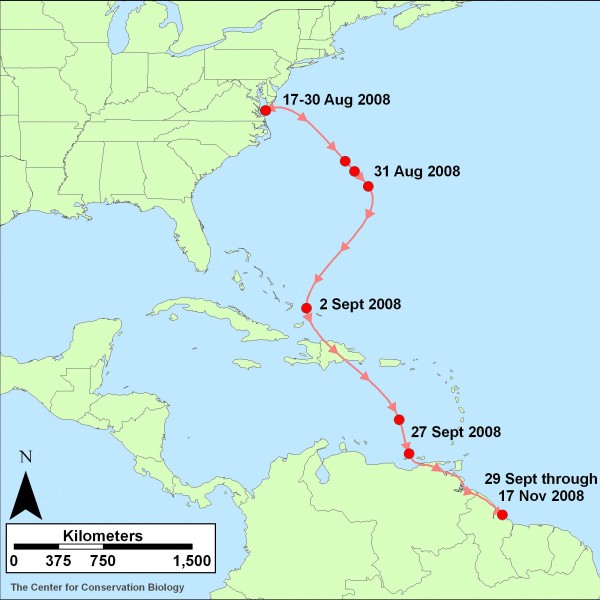Whimbrel migration tracking
Aerial survey of the Pacific coast of Panama for waterbirds completed
October 11, 2008Fort Lee avian inventory – a continuing CCB – DOD partnership for conservation
October 13, 2008
Written by Fletcher Smith & Bryan Watts
October 12, 2008

Whimbrel tagged on the Eastern Shore of VA, August 2008. Photo by Libby Mojica.
The whimbrel is a large shorebird that has a relatively well known breeding and winter distribution. The new world form breeds in two disjunct populations including the northwest from northern Alaska to the Yukon Territory and then near the southwestern shoreline of Hudson Bay. These birds do winter in low numbers in coastal areas of southern North America but primarily in Central and South America. Much less is known about migration routes and important migratory staging areas. From a broad conservation perspective, it is important to link breeding and winter populations and to delineate critical staging areas used by birds while in transit.
In an attempt to fill information gaps about the migration of whimbrels along the Atlantic Coast, CCB has joined with The Nature Conservancy to use state of the art satellite transmitters to track birds during their migration. In the spring of 2008, CCB fitted a whimbrel with a 9.5 gram, satellite transmitter manufactured by Microwave Telemetry, inc. and tracked a bird from the Virginia to its breeding ground on the North Slope of Alaska. On August 14 of 2008, CCB trapped a bird on its southerly migration and fitted it with a similar transmitter to investigate fall staging areas, routes and winter grounds.

Map of released whimbrel’s travel, tracked by satellite transmitter from Virginia’s Eastern Shore to the coast of Guyana, South America. Map by the Center for Conservation Biology.
The bird left the Eastern Shore of Virginia on 29 August, 2008 and flew out over the Atlantic approaching within 200 miles of Bermuda and then turning south. At this time there were 3 major storms moving toward the Caribbean. The bird flew directly into the eye of Hurricane Hannah and made landfall on the northeastern shore of the small island of Mayaguana in the Bahamas. The island was hit by both Hurricanes Hannah and Ike while the bird was grounded there. The eye of Hurricane Ike, a category 4 storm, passed within 50 miles of the island. After staging in this location for more than 3 weeks, the bird flew south toward Venezuela, making landfall in Guyana on 29 September. This bird revealed a migratory route that is likely a routine route for this species and a wintering ground with extensive inter-tidal mudflats.
The new tracking technology is allowing researchers to have a view into migration strategies that was never possible before. CCB and TNC have plans to continue this work during the spring of 2009.



